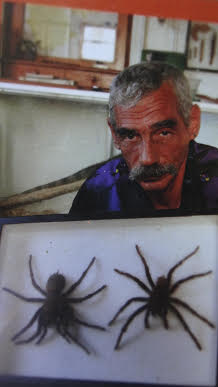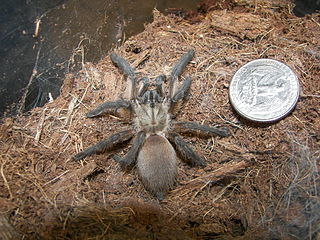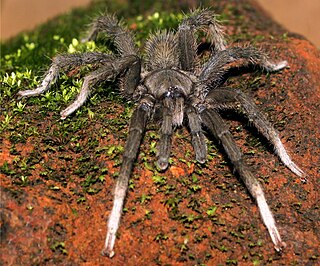
The Goliath birdeater belongs to the tarantula family Theraphosidae. Found in northern South America, it is the largest spider in the world by mass and body length, and second to the giant huntsman spider by leg span. It is also called the Goliath tarantula or Goliath bird-eating spider; the practice of calling theraphosids "bird-eating" derives from an early 18th-century copper engraving by Maria Sibylla Merian that shows one eating a hummingbird. Despite the spider's name, it rarely preys on birds.

Theraphosa is a genus of South American tarantulas that was first described by Charles Athanase Walckenaer in 1805. The Theraphosa spiders are some of the largest known to science. As of May 2020 it contains three species, found in Guyana, Brazil, Venezuela, and Colombia. They stridulate by rubbing setae on their pedipalps and legs.

Tarantulas comprise a group of large and often hairy spiders of the family Theraphosidae. As of December 2023, 1,100 species have been identified, with 166 genera. The term "tarantula" is usually used to describe members of the family Theraphosidae, although many other members of the same infraorder (Mygalomorphae) are commonly referred to as "tarantulas" or "false tarantulas". Some of the more common species have become popular in the exotic pet trade. Many New World species kept as pets have setae known as urticating hairs that can cause irritation to the skin, and in extreme cases, cause damage to the eyes.

Theraphosa apophysis is a species of spider in the family Theraphosidae, found in Venezuela, Colombia and Brazil.
The Ischnocolinae are a problematic subfamily of tarantulas. In 1892, Eugène Simon based the group, which he noted was only weakly homogeneous, on the presence of divided tarsal scopulae. This feature was later considered to be plesiomorphic, and both morphological and molecular phylogenetic studies have shown that, as traditionally circumscribed, the subfamily is not monophyletic. A much more narrowly defined Ischnocolinae sensu stricto was proposed in 2014. One of the authors of that proposal subsequently said that no further taxonomic changes should be considered until there had been a more comprehensive sampling of the subfamily. As of January 2021, the status of the Ischnocolinae remains unresolved.

Neoheterophrictus is a genus of tarantula in the family Theraphosidae. It comprises 8 species, all found in India.
Neoheterophrictus bhori is a species of tarantula. It is native to Parambiculam, Western Ghats, Cochin province, India, in present-day Kerala state.
Annandaliella ermakulamensis is a species of tarantula in the subfamily Selenogyrinae. It is one of three species in the genus Annandaliella and the first to be described in 73 years. It is native to Ernakulam, Kerala State, India.

The Eumenophorinae are a subfamily of tarantula spiders. They are known from genera distributed across Sub-Saharan Africa, the south of the Arabian peninsula, Madagascar and its associated islands, and parts of India.
Neoheterophrictus amboli is a species of theraphosid spiders, which is found in India.

Neoheterophrictus smithi is a species of tarantulas, native to India.
Haploclastus psychedelicus, synonym Thrigmopoeus psychedelicus, is a theraphosid spider. It is native to India.
Neoheterophrictus madraspatanus is a species of spider in the family Theraphosidae, found in India.
Augacephalus is a genus of harpacterine theraphosid spiders. It has three species, all of which are found in Africa.
Augacephalus breyeri is a species of harpactirine theraphosid spider, found in South Africa, Mozambique and Eswatini.

Haploclastus is a genus of Indian tarantulas that was first described by Eugène Louis Simon in 1892. It is considered a senior synonym of Phlogiodes.
Heterophrictus is a genus of Indian tarantulas that was first described by Reginald Innes Pocock in 1900.
Longilyra is a genus of spiders in the family Theraphosidae. It was first described in 2014 by Gabriel. As of 2017, it contains only one species, Longilyra johnlonghorni, found in El Salvador. This genus differs from the others as it has stridulatory bristles. It is different from those who have them on the same segments such as the Acanthoscurria genus because of the palpal bulb with a very short and acuminate embolus and four short keels, separated tibial apophysis. Females can be separated from the others by the spermathecae with two seminal receptacles with elongated ducts emerging from a common area.

Langona warchalowskii is a species of jumping spider in the genus Langona that lives in South Africa. It was first described by Wanda Wesołowska in 2007. The spider is large with a carapace between 3 and 4 mm long and a abdomen between 2.4 and 5.8 mm. The male is significantly smaller than the male and has deeper colours. The spider has a black head, dark brown thorax and brown-black abdomen. While all the spiders have two stripes along the carapace, some have one on the abdomen and some and three. The toothless chelicerae is typical of the genus. The male can be distinguished by its copulatory organs, and particularly its short and blunt tibial apophysis. The female also has distinctive copulatory organs, including an epigyne with two small depressions, the rims of which form a shield over the gonopores.

The Selenocosmiinae are a subfamily of tarantulas found throughout South-East Asia and Australia. This subfamily is defined by the presence of a lyra on the maxillae and strikers on the chelicerae, allowing these spiders to stridulate and produce a "hissing" sound. However some species within Phlogiellus may have secondary lost their lyra but retain their strikers. The monophyly of the subfamily has been only tested using genetic data with a handful of genera or species in a few studies. However, these studies found genera that had been previously placed in this subfamily were actual their own separate subfamily (Poecilotheria) and that Selenocosmiinae is most closely related to the Indian Thrigmopoeinae. As of 2021, Selenocosmiinae contains 11 genera.








